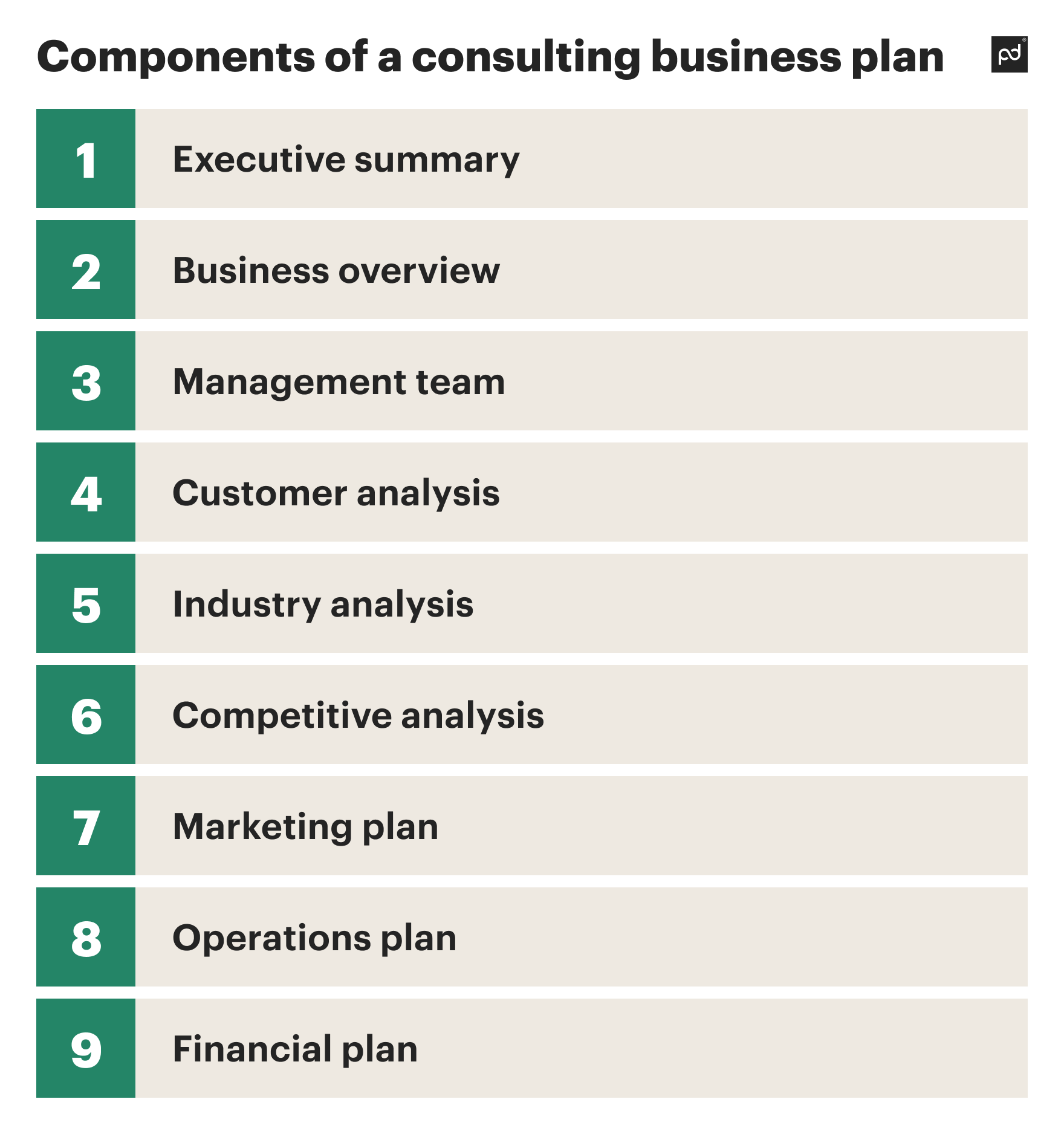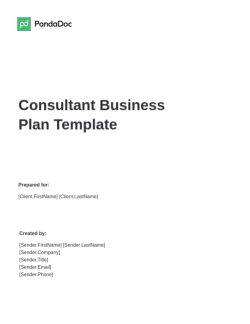Ever tried to put up a tent blindfolded? Navigating the consulting world without a business plan can feel the same overcomplicated.
We created this guide to help you set a strategic, actionable plan on how to operate your early-stage consulting business.
We’ll help you define your services, set achievable and clear goals, and arrange strategies for growth.
So are you ready to pitch your tent with both eyes open?
Key takeaways
- A consulting business plan starts with defining your unique selling proposition (USP). Identify a niche and ideal client by conducting thorough market research and competitive analysis.
- Develop a 12-month marketing strategy with specific targets. Allocate 10-15% of projected revenue to marketing for optimal results.
- Realistically estimate your expenses and revenue based on billable hours/fees and retention rate assumptions.
- Use a proven template rather than starting from scratch to not overlook important elements of the plan.
What is a consulting business plan?
A business plan is a document covering all the aspects of your future consulting business in terms of achieving business goals.
In other words, this specific plan removes the guesswork from how one runs their consulting business.
In the upcoming sections, we’ll explain the key pieces needed to create your business plan.

Your consulting business plan should offer a detailed overview of your consulting firm.
Let’s briefly review the essential sections of the plan and what should be in each of them.
- Executive summary is a short overview of the main points of the document.
- Business overview highlights the mission, vision, history, and services offered by the consulting firm.
- Management team provides bios and expertise of key team members.
- Customer analysis defines target clients, their needs, and how the consulting service solves their problems.
- Industry analysis evaluates the landscape including growth, trends, regulations, and competition.
- Competitive analysis compares the consulting firm’s positioning and offerings versus competitors.
- Marketing plan outlines promotional strategies, lead generation, and metrics.
- Operations plan details the logistics of service delivery, staffing, resources, and customer service principles.
- Financial plan projects costs, revenue, cash flow, and profitability timelines.
Key steps for developing your consulting business plan
Building a thriving consulting business requires thorough planning and a keen eye for detail. Let’s walk through this journey step-by-step.
Step 1. Identify your niche and ideal clients
Kick off your business plan by diving deep into industry research. Look for sectors and trends where there’s a gap that your expertise can fill.
To validate the demand, consider surveying potential clients.
Once you’ve got a handle on that, create a detailed profile of your ideal client, considering factors like their company size, revenue streams, challenges, and objectives.
By the way, focusing on ideal buying personas in B2B (with all these fictitious names, bios, etc.) is one of the greatest sales mistakes, according to Corporate Visions’ findings and Gartner B2B sales research results.
Step 2. Analyze the competition
Understanding your competition is crucial. Examine competitor services offered, how they are marketed, and what they charge.
This is your chance to find your unique selling proposition.
Step 3. Set your rates and service packages
Following the actual industry norms to appoint your consulting fees. However, the price that you use should mirror both your expenses as well as the premium value that your expertise brings to your clients.
Let’s say you work out your overhead costs (utilities, office rental, equipment, etc.) to be roughly $50 per hour, while your hourly work value, which includes your experience and knowledge in this field, is $100.
So, your primary costs in total for an hour of consultation would be $150.
A standard practice in the consulting industry is to have a 100% markup rate on your primary costs.
Applying that rule to your scenario would mean doubling your total cost of $150, which brings your final hourly rate to $300.
Create bundled service packages that combine different services, such as business strategy consultation, market analysis report, and a follow-up action plan. You can offer these at a discounted rate compared to purchasing each service individually.
For example, Bronze is an entry-level package with initial consultation and some basic professional business advice.
Silver is a mid-tier package covering everything from the Bronze plus a detailed action plan for improving business operations.
Finally, the Gold package is a top-tier one complementing what’s in Silver with extended support and follow-ups.
Step 4. Create a marketing and client acquisition strategy
Outline a 12-month marketing strategy that includes a mix of content marketing, events, referrals, and lead-generation campaigns.
Set achievable targets for each quarter, focusing on metrics like leads generated, sales appointments set, and deals closed.
When it comes to budgeting, aim to allocate 10%-15% of your projected revenue or even more to marketing.
According to Gartner, the average startup spends 11.2% of its revenue on marketing.

Step 5. Calculate potential project expenses and revenue
You’ll need to account for various expenses, including staffing, office space, equipment, software, and marketing.
Don’t forget about professional services, travel, and other overhead costs.
On the revenue side, forecast your monthly earnings based on projected billable hours or fixed fees, and assume a client retention rate between 80%-90%.
Extend these projections to create 3 to 5-year profit and loss statements and cash flow forecasts.
Step 6. Plan for sustainability and growth
Your business plan shouldn’t just be a launchpad; it should be a roadmap for long-term growth.
Given that self-funding for growth beyond 20% annually is often unrealistic for most consulting firms, you’ll need a plan B.
One smart move is to establish strategic financial partnerships with investors, banks, or other financial institutions.
These partnerships can offer the capital injection you need to scale your services, break into new markets, or even acquire other businesses.
More than just a financial lifeline, these partnerships can also provide invaluable business insights and open doors to new opportunities.
Step 7. Use an appropriate consulting business plan template
Having a consulting business plan template is like having a roadmap for your contractual relationships.
It ensures you don’t overlook key elements such as scope, payment terms, and legal considerations.

Consultant Business Plan Template
Used 4999 times
An example of a document outlining your strategy for launching or expanding your consulting firm is a Consultant Business Plan Template. The essential elements include a summary of the company, team, sector, rivals, target audience, and an operations and marketing strategy.
Use this templateCustomize it and review it with a legal advisor to ensure compliance.
Why developing a consulting business plan is so important
Let’s talk about the positive outcomes of planning. A well-defined consulting business plan…
…directs your business operations
A business plan defines your strategy and major goals, simplifying day-to-day decision-making and helping you focus on long-term objectives.
In other words, you know what to do next at any given moment of operating your early-stage consulting business.
…mitigates your risks
With a comprehensive business plan in place, you can anticipate and prepare for potential challenges, turning risks into opportunities.
…attracts investors
If you want to secure investments, the first thing venture investors or business angels will ask you for is (surprise, surprise) a business plan.
Not just any plan, but a detailed, convincing blueprint of your consulting business that highlights growth and potential returns.
Wrapping up
A well-crafted consulting business plan is essential for guiding your strategy, operations, marketing, finances, and growth.
Carefully working through each component will ensure you launch your firm following a clear plan on how to achieve success.
Using business planning platforms like PandaDoc that offer templates and tools can help streamline creating a professional plan.
The software also enables real-time collaboration so you can work seamlessly with colleagues and advisors.
Disclaimer
PandaDoc is not a law firm, or a substitute for an attorney or law firm. This page is not intended to and does not provide legal advice. Should you have legal questions on the validity of e-signatures or digital signatures and the enforceability thereof, please consult with an attorney or law firm. Use of PandaDocs’ services are governed by our Terms of Use and Privacy Policy.


